New Delhi: Prada’s technical team flew all the way to Kolhapur earlier this week to buy seven pairs of ‘Moje Puda Kapshi’ Kolhapuri chappals and visit several manufacturing units in the city. Now, local artisans are gearing up for bulk orders.
The team from the Italian fashion house met Kolhapuri footwear artisans during their two-day visit (from 15 July to 16 July), just weeks after controversy erupted over the brand’s use of Kolhapuri chappals in their Spring/Summer collection.
“They are interested in working with us not just for Kolhapuri chappals, but also for silver and all possible handmade crafts,” Prasad Bhopal Shate, Director of the Kolhapur Footwear Association, told ThePrint.
The four-member team, on 15 July, visited several facilities, including the LIDCOM (Sant Rohidas Leather Industries & Charmakar Development Corporation Limited) centre, Karakari Leather Works, the Kolhapuri chappal women artisans’ cluster in Kagal, and the production units run by Sunil Lokare and Rohit Gavali.
“Indian brands/fashion designers were working toward highlighting the regional craft, but they couldn’t build a global platform—something Prada already has. This collaboration will benefit us,” said an optimistic Shate.
He also shared that Prada has asked MACCIA (Maharashtra Chamber of Commerce, Industry and Agriculture) to produce a documentary showcasing the variety of Kolhapuri chappals and the materials used in their making.
Shate, who runs his family’s 70-year-old Kolhapuri chappal manufacturing unit, Pooja Footwear Kolhapur, was impressed by the team. “On the second day, they spent a full seven hours at our unit in Subhash Nagar, without even stopping for food.”
Prada’s business delegation is expected to return later this year and plans to partner with MACCIA to formalise the collaboration.
Preparing for bulk orders
The visiting Prada team included Paolo Tiveron, Director of the Men’s Technical and Production Department—Footwear Division; Daniele Contu, Pattern Making Manager—Footwear Division; along external consultants Andrea and Roberto Pollastrelli.
According to Shate, the team showed interest in the machinery used in Kolhapuri chappal production but were surprised to learn that only 10–20 per cent of the process involves machines; the remaining 80 per cent is purely handcrafted.
Influencer Krishnaraaj Mahadik, who flagged Prada’s use of the Kolhapuri chappal design to the Maharashtra government, said Prada officials carefully observed each step, from sourcing and curating the leather to shaping the final product, and took detailed notes.
“There’s no denying that the Kolhapuri chappal design and Prada’s sandals are almost identical,” Mahadik pointed out. “But the quality of leather makes all the difference. The least they could’ve done is name it ‘Kolhapuri Chappal’.”
Though he wasn’t in town during the visit, Mahadik said he joined a video call with association members soon after the team left.
“They sounded happy and hopeful that their hard work and craft might finally be acknowledged,” he said.
Shate sells Kolhapuri chappals ranging from Rs 1000 to Rs 35,000.
“The cost of a Kolhapuri depends heavily on the leather,” he said. “Ox or bullock leather is expensive, which pushes the price up. Sheep and goat leather come next, while buffalo leather is cheaper as it is easily available.”
The association also held a meeting yesterday to discuss future plans.
“Our focus now is to set up training centres in Kolhapur to pass on the craft to the next generation,” Shate said. “Most of the current artisans are ageing. We want a strong, young team in place before any bulk orders come in.”
(Edited by Theres Sudeep)






